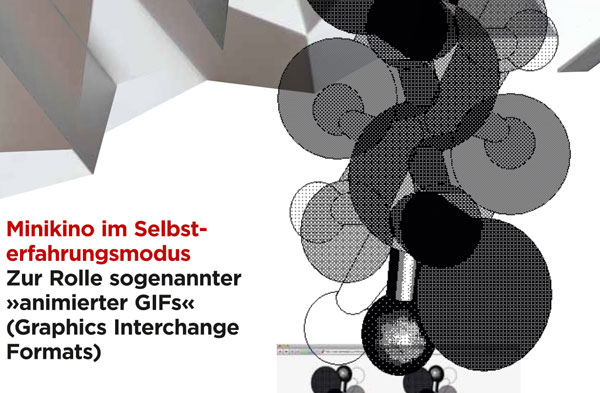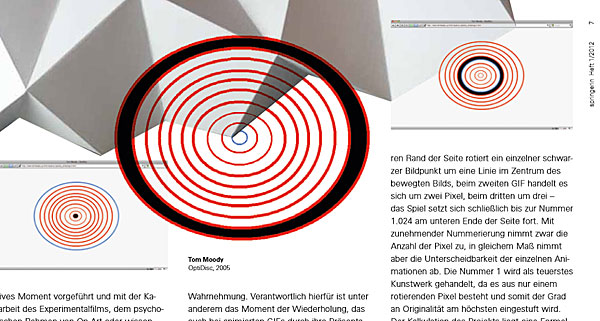"Wah Wah Champ" [mp3 removed]
Fun with my new arpeggiator(s).
"Vintage"
"Woodchipper Gardens" [mp3 removed -- a remixed version of this track appears on Bandcamp]
Playing around with some new software, not that this is a radical departure.


Some of my animated GIF work was discussed in the German magazine Springerin.
Franz Thalmair wrote, in part (English translation):
Animated GIFs treat every single frame as a level within one and the same image. When producing animated GIFs, a display time is defined for each image, with one frame either entirely replacing the next or being superimposed upon it. The sequence is generally presented as an endless loop.
The visual language of animated GIFs, which Olia Lialina and Dragan Espenschied describe as "digital folklore" or "demotic Web" arises out of a bewildering mixture of "online-amateur culture, digital DIY electronics, dirtstyle, typo-nihilism, memes, teapots, penis enlargements." Take a look at OptiDisc and Double Double Centrifuge, two of the numerous works by Tom Moody circulated on the Web, and the function of animated GIFs in an artistic context becomes clearer. OptiDisc is made up of 18 individual frames and depicts ten red ellipses arranged concentrically; the animation makes them turn blue, with the colour moving from the inside to the outside and back to the centre again, whilst the spaces between them become filled with black in a counterpoised – and equally pulsating – movement. In contrast, the animated GIFs in Double Double Centrifuge are made up of only eight individual images, but here we find two double centrifuges arranged parallel to each other, and creating a moiré effect with a range of grey tones and various surface textures as they rotate on their own axis. The type of phenomena we usually find annoying when surfing – a permanently flickering background image, a rotating globe when a commercial firm wants to depict its global network, or body parts that grow and shrink to promote an advertising promise of two more centimetres – are presented by Tom Moody as contemplative elements and associated with the work on framing to be found in experimental film, the psychological framework of Op-Art or scientific visualisation methods – in other words, with the visual language of Modernism.
and
Numerous art practices today repeatedly confront viewers with the conditions of their own perception, in a fashion comparable to the non-linear movement of a loop. One of the aspects responsible for this is repetition, which also enters into play in animated GIFs through their presentation as an endless loop, and provides a vector to articulate political demands. This persistence in an endless loop and interruption of the quotidian chain of perception arising from patterns of repetition is, as Diedrich Diederichsen notes, "not a disappointing process because it leads back to its own beginning. It is the same thing, experienced at least twice by me. It is objectively the same and hence it is a possibility to observe the changes in my experiencing subjectivity, to have a second-order experience of change" – and hence to distance oneself from the normative classification criteria of everyday life.
[footnotes omitted]
FYI OptiDisc (official "smooth" version)
Double Double Centrifuge
PDF of the German version (very happy with this design -- screenshots of the PDF are above)